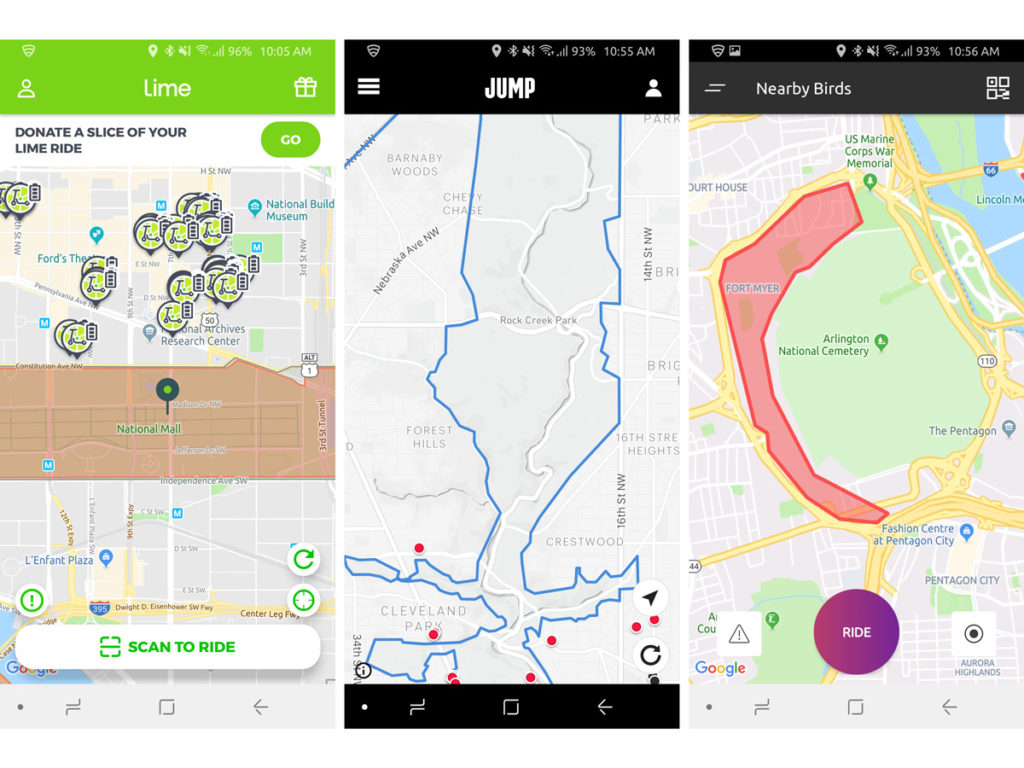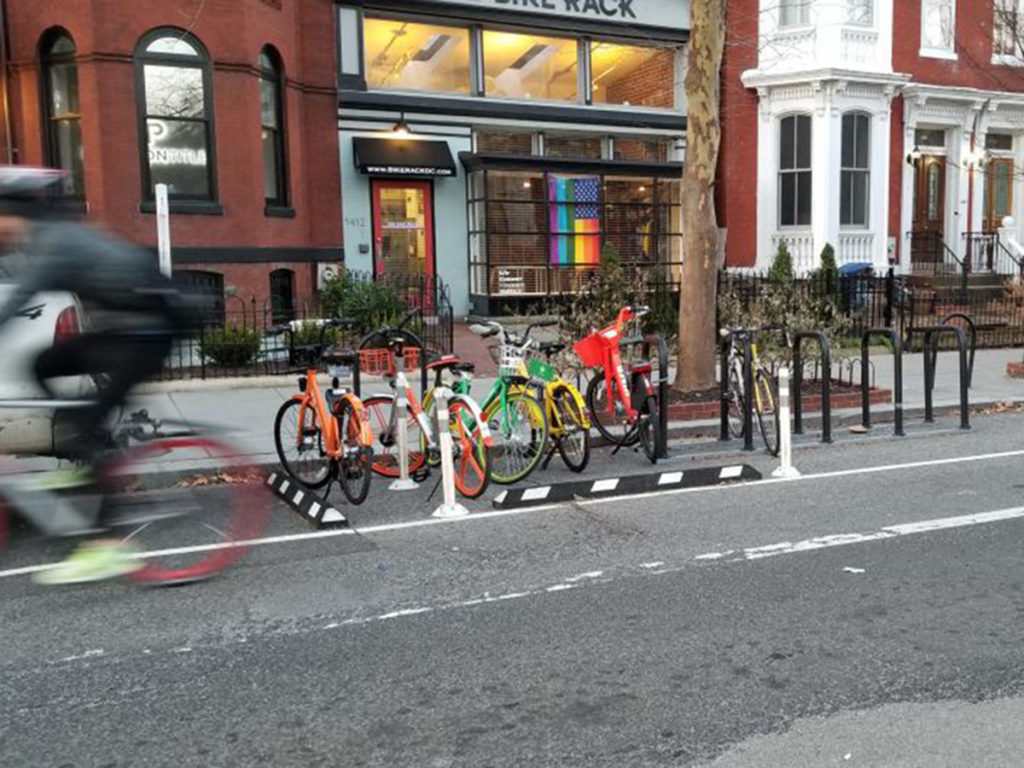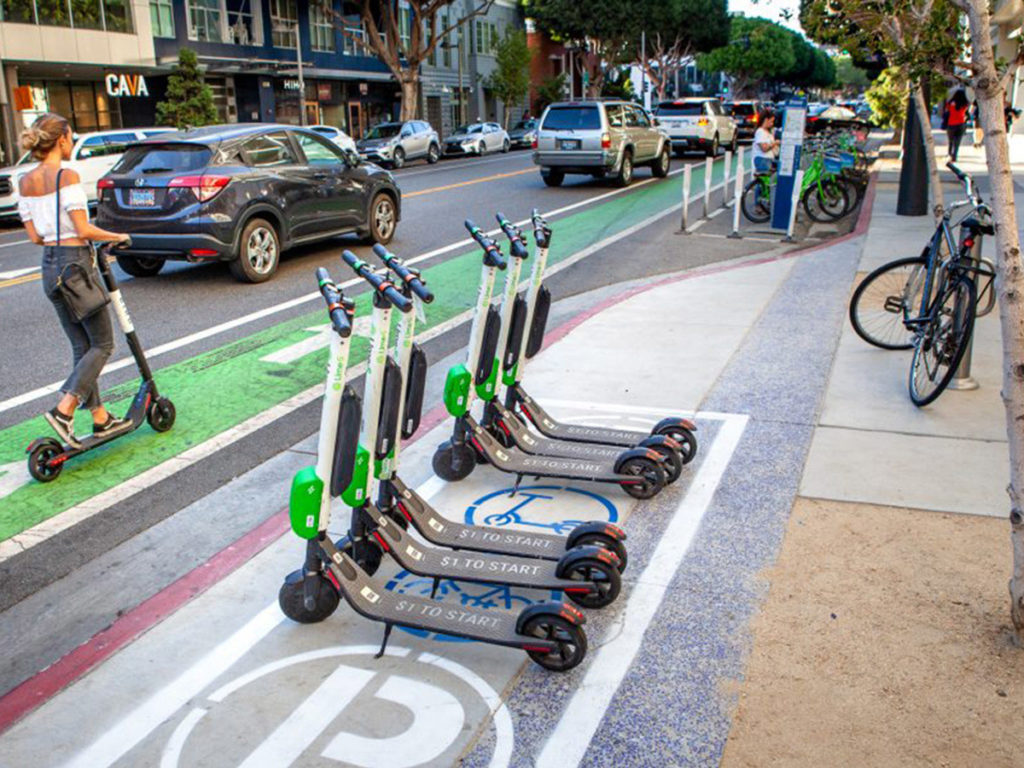Introduction
One of the biggest challenges facing cities since the introduction of shared micromobility services is where these vehicles should operate as well as where they should be parked and stored when they’re not in use.
With a general lack of dedicated, protected infrastructure for active transportation and micromobility users, cities will need to determine where it’s safest for these vehicles to operate and may need to build out new dedicated space for active transportation and micromobility users.
This challenge is coupled with users struggling to park and store vehicles properly — often creating obstructions on sidewalks, the right-of-way and in other public space, creating safety hazards, accessibility issues and slowing down foot and vehicle traffic. Cities will need to determine the best options for their community, such as requiring vehicles to be locked to physical infrastructure, use-specific and marked parking zones, or whether users can park anywhere as long as it isn’t blocking the sidewalk or right-of-way.
Regardless of the preferred regulations on where they should be operated and parked, cities and operators will need to communicate clearly and educate residents and users on these regulations.
National Standards
All local governments developing shared micromobility policies should include these general provisions to ensure that their regulations address these issues similarly across communities.
-
1
New Street Designs
Cities need to update their street design guidelines to include shared micromobility services and active transportation to create protected and safe spaces for user and riders.
Policy Sections
Parking Requirements
Vehicle storage and parking is one of the main challenges cities face when managing shared micromobility services. After their initial deployment in cities, dockless bikes and scooters were often left parked in the right-of-way, blocking vehicle or pedestrian traffic. While improving, it has taken users time to better understand where and how to store these vehicles properly. Cities will need to determine how best to manage where these vehicles should park in order to mitigate some of their negative impacts.
Designated Areas Where Parking Is Permitted
Specific areas where users must park their vehicles. Can be established through demarcating areas in the furniture zone or right-of-way, converted parking spaces, or through geofencing.
Pro
Creates clear rules for parking; users do not have to spend time looking for a parking space; reduces the likelihood of vehicles blocking sidewalks and the right-of-way; makes parking easier to manage and enforce; leverages existing bike racks and other physical infrastructure; does not require companies to deploy new vehicles that can adhere to lock-to requirements.
Con
May not solve issue of vehicles falling outside of painted box and blocking sidewalk or right-of-way; geofencing technology isn't precise enough for enforcement; creates extra infrastructure to maintain; difficult to communicate about parts of city that have required parking areas and parts that don't; may undermine the free-floating flexibility that makes dockless systems attractive to consumers; choosing designated parking areas may be a prolonged process, because the city must determine the areas parking will be placed and procure a vendor to demarcate the spaces.
Case Study
Seattle, WA
Devices may be parked upright on hard surfaces in the landscape/furniture zone of sidewalks. If there’s no sidewalk, riders may park in a safe location that does not impede other street uses or obstruct pedestrians. Riders can also park at any Seattle Department of Transportation bike rack or corral. Seattle's Free-Floating Bike Share Program Permit Requirements
Designated Areas Where Parking Is Prohibited
Does not set out or require areas for parking, but clearly spells out all of the areas where vehicles should not be parked.
Pro
Keeps vehicles from blocking sidewalk or roadway.
Con
Does not help to create safe and easily identifiable areas for users to park vehicles, making parking more challenging for users and more difficult for city to manage.
Case Study
Charlotte, NC
Charlotte has created very clear guidance on where vehicles should not be parked. This includes areas in the pedestrian zone adjacent to or within these areas:
parklets or sidewalk dining; transit zones, including bus stops, shelters, passenger waiting areas and bus layover and staging zones, except at existing bicycle racks; loading zones; accessible parking zones and associated loading zones; street furniture that requires pedestrian access; curb ramps and signal push buttons; entryways, exits and must maintain a 10 foot clearance; and driveways. Charlotte's Dockless Bike / E-Scooter Share Permit Requirements
Lock To Physical Infrastructure
Requires all vehicles have the equipment necessary to be locked to physical infrastructure when parked.

Pro
Reduces the likelihood of vehicles blocking sidewalks and the right-of-way; makes parking easier to manage and enforce; leverages existing bike racks and other physical infrastructure.
Con
Less flexible than a non-locking system, requires additional infrastructure on bikes and vehicles; cities may not have enough bike racks for vehicles to comfortably park in all areas; many companies do not have vehicles that can comply with these standards, especially scooters; bike racks and appropriate infrastructure may be in low supply in some residential or disadvantaged communities undermining the ability of operators to serve those communities.
Case Study
Washington, DC
Washington, DC has updated its dockless vehicles permit to require that bicycles are equipped with a locking mechanism that affixes the bicycle to an independent, stationary object when parked. This regulation doesn't apply to scooters. Washington, DC's Dockless Vehicle Permit Application
Unrestricted Parking
Users can park vehicles anywhere as long as they don't restrict the movement of the sidewalk or right-of-way.
Pro
More flexible and scalable than a restricted parking system; users do not have to spend time looking for a parking space; does not require new city infrastructure; does not require companies to deploy new vehicles that can adhere to lock-to requirements.
Con
Vehicles more likely to block sidewalks and create unsafe conditions; harder for city to manage vehicle parking than with designated areas; vehicles can be knocked over or fall over accidentally.
Case Study
Durham, NC
Durham only requires that shared devices shall not be parked in a way that may impede the regular flow of vehicular and pedestrian travel in device operating areas or otherwise cause a violation of the City Code: Durham's Shared Active Transportation Ordinance
Recommendations
Cities may consider hybrid models with any of these. For example, within specific, denser areas, cities could require one parking policy, but have a different parking policy in the rest of the community. Cities should also convert current on-street parking spaces to shared micromobility parking spaces or corrals to accommodate more vehicles and foster the adoption of these services.
Cities, in close partnership with operators, will need to clearly communicate their parking requirements to residents and riders through both physical and digital means as well as through traditional communication channels.
Parking Infrastructure
Cities have seen a significant increase in the number of micromobility vehicles that are vying for limited parking space in the right-of-way. To accommodate this growth, in pairing with specific parking requirements, cities should build out new parking infrastructure to ensure these vehicles can be parked and stored safely and out of the way of pedestrians and other vehicles while not in use.
Bike racks
Small micromobility vehicles are parked using existing and new bike rack infrastructure.

Pro
Uses existing infrastructure where its purpose is already understood by general public; relatively inexpensive and quick to install or expand; can serve as additional parking for personal micromobility vehicles; addresses issues with improperly parked devices by providing clearly communicated space and physical support to organize devices.
Con
May overwhelm existing racks and infrastructure; may overtake space used by personal bikes and micromobility vehicles; new racks can only be installed in areas with sufficient space; will take staff time and resources to identify areas for use and expansion.
Demarcated Parking Areas
Parking areas that are clearly marked and designated with symbols, paint, tape, or thermoplastic.

Pro
Relatively inexpensive and quick to install or expand; easily understood by general public; may address sidewalk blockage issue.
Con
If in the furniture zone, may create unintended sidewalk blockage issues if vehicles aren't parked properly or fall over; may encourage sidewalk riding depending on their location; may be limited space in the busiest, most desirable areas for micromobility usage; will take staff time and resources to identify areas for use; may require a prolonged period of time for cities to designate areas, procure services to mark the areas; will require some resources for maintenance and upkeep.
Case Study
Santa Monica, CA
A pilot designated dockless scooter and bike zone on 2nd. St in downtown Santa Monica utilizing street space and a curb bulb out space created at a mid-block crosswalk. The City of Santa Monica is repurposing street space to create shared mobility device zones. Zones are being installed citywide with a focus on major boulevards and neighborhood destinations. Over 60 zones have been installed in the first few months of the city’s pilot program. City staff are scoping locations with input from operators regarding demand in specific locations. Photo from Santa Monica Next
Geo-fencing
A geo-fence is a virtual perimeter for a real-world parking area. Geo-fences can be established by the city and show virtually within each operator's app.

Pro
Requires no infrastructure; easy to identify areas for parking and no parking.
Con
Not accurate enough yet; GPS can be spotty in urban areas with tall buildings and is generally not precise enough to determine parking compliance; will take staff time and resources to identify areas for use; not easy for user to determine without use of the app; would require significant education and communications; likely better used for operational domain and larger scale applications.
On The Sidewalk
Shared micromobility vehicles can be parked anywhere on the sidewalk in the furniture zone.

Pro
May address sidewalk blockage issue; the use of furniture zone is already understood by general public; can help riders visualize and learn the actual pedestrian throughway; doesn't require any infrastructure or investment.
Con
Space may not be available in areas where the sidewalk isn't wide enough or doesn't have a furniture zone; may create unintended sidewalk blockage issues if vehicles aren't parked properly or fall over; may encourage sidewalk riding; would require significant education and communications to ensure understanding and compliance; may be limited space in the busiest, most desirable areas for micromobility usage.
Case Study
Washington, DC
Lime electric scooters parked on the sidewalk in Washington, D.C. Photo from Joe Flood via twitter
Street corrals
Parking areas that have been designated and marked on the street, such as in a car parking spot. Some cities are testing adapting block ends near intersections, no-parking zones and other areas that do not interfere with bike, pedestrian or other traffic operations.

Pro
Can be relatively inexpensive and quick to install or expand; easily understood by general public; addresses sidewalk blockage issue; adapted spaces can serve multiple functions; promotes active transportation and micromobility usage by creating dedicated parking spaces and increasing visibility.
Con
Typically takes parking spaces when not designated in adapted spaces; may require minor infrastructure to establish and delineate space; may be limited space in the busiest, most desirable areas for micromobility usage; will take staff time and resources to identify areas for use; may be time consuming to install in cities without established corral programs; will require resources for maintenance and upkeep.
Case Study
Washington, DC
A parking space that's been converted to a street corral in Washington, DC. Photo from DDOT

Recommendations
Cities should build or dedicate a variety of parking infrastructure based on the individual needs and circumstances of their community as well as the specific identified areas. Each of these different parking choices have their own advantages and use cases that will depend on specific city or neighborhood needs. Parking infrastructure should also be located near transit or other mobility services to encourage transit use and multimodal behavior.
Regardless of the parking infrastructure desired for these vehicles, cities will need to dedicate staff time and resources to identify and establish appropriate areas, create and maintain infrastructure and communicate with users and residents about proper use. Cities should also consider these costs when determining permit or registration fees as well as dedicate a portion of the revenue generated for these needs.
Cities should partner with operators when determining parking policies, placements and designated areas, signage and communications and consider having operators contribute financially to the maintenance and upkeep of these areas.
Operational Domain
While shared micromobility vehicles can create safety issues while parked, users also face safety issues while operating them in the right-of-way. Active transportation and micromobility vehicles have always faced safety challenges, even in cities with a robust network of bike lanes, but the concern is particularly acute in communities that do not have bike lanes or a culture of active transportation where micromobility vehicles are now operating alongside cars and buses. Cities will have to set clear guidelines for where these vehicles should be operated to make sure roads are safe for all users and they’ll also need to provide the funding or infrastructure necessary to enhance safety through dedicated bike lanes and other infrastructure.
Sidewalk
Vehicles required to operate on sidewalk at all times.
Pro
No new infrastructure; users are not threatened by cars; users may feel safer operating away from the rest of the road network.
Con
Vehicles take up pedestrian space; may put pedestrians in harm due to speed differential; put users in harm if sidewalk is not well maintained or wide enough for operation.
Case Study
Denver, CO
Bicycles and e-bicycles deployed as part of this pilot program will be required to follow all rules of the road when in use. Please note that e-bicycles are permitted to use roadways internal to designated parks but are not permitted to use Parks maintained trails. According to current City and County of Denver Ordinance and State Law, e-scooters are classified as “toy vehicles” and will be required to
operate on the sidewalk. All vehicles must yield to pedestrians at all times. E-scooters will not be allowed in striped, protected or otherwise designated bike lanes. E-scooters will not be allowed to operate within designated parks or on Parks maintained trails. Denver's Dockless Mobility Vehicle Pilot Permit Program Overview
Street
Vehicles required to operate on the street at all time.
Pro
No new infrastructure; users are not taking up sidewalk space; users have additional room to operate in the road.
Con
Creates safety hazards to operate alongside cars and other high-speed vehicles, especially in dangerous or busy intersections; does not carve out safe, protected space in the absence of a robust bike network.
Case Study
Various
Most cities' regulations clearly state that operations should occur in the street and follow standard rules of the road and that riding on the sidewalk is prohibited.
Unrestricted
Vehicles can operate anywhere in the city.
Pro
Users able to operate anywhere that make sense for them; allows users to avoid busy or dangerous roads or sidewalks when necessary.
Con
Does not carve out safe, protected space; creates safety hazards for vehicles operate alongside cars, especially in dangerous or busy intersections; may put pedestrians in harm due to speed differential; difficult to manage or set up right-of-way to allow for their safe operation; avoids the creation of a consistent culture for where and how these vehicles should be operating.
Active Transportation and Micromobility Lanes
Vehicles are encouraged to operate in specific, dedicated lanes for their use.
Pro
Creates a safe and efficient space for these vehicles in the right-of-way.
Con
Can add costs to build out infrastructure and lane network; will require political will and funding support.
Recommendations
Cities should be clear with companies and users about where these vehicles should be operated. As most active transportation and micromobility riders are vulnerable road users, it will be important to designate safe spaces for their operations. Cities will also need to check that their choices aren’t in conflict with their state’s law governing these vehicle types.
The rapid popularity and proliferation of micromobility services offers cities an opportunity to dedicate greater lane space and create protected spaces for micromobility and active transportation users. Cities should strive to open as many spaces as reasonably possible to micromobility and create a consistent culture for where and how these vehicles may be operated.